Geology, Apatite Geochronology, and Geochemistry of the Ernest Henry Inter-lens: Implications for a Re-Examined Deposit Model
Abstract
1. Introduction
2. Geological Background
2.1. Regional Geology
2.2. Deposit Geology
2.3. Previous Deposit Models
3. Geology and Mineral Paragenesis of the Inter-Lens
3.1. Protolith Geology
3.2. Mineral Paragenesis of the Inter-Lens
3.2.1. Albitization
3.2.2. Apatite-Calcite-Quartz-Garnet
3.2.3. Biotite-Magnetite ± Garnet Alteration
3.2.4. K-Feldspar ± Hornblende Alteration
3.2.5. Ore-Stage Cu-Mineralization
3.2.6. Post-Mineralization Calcite ± Quartz Veining and Chlorite-Sericite Alteration
3.3. Structural Similarities to the HWSZ and FWSZ
4. Materials and Methods
4.1. Sample Information (Apatite Geochronology and Trace Element Analysis)
4.2. Apatite U–Pb Geochronology
4.3. Trace Element Analysis
5. Analytical Results
5.1. Apatite U–Pb Geochronology
5.2. Trace Element Data
6. Discussion
6.1. The Inter-Lens Protolith and Similarities with the FWSZ, HWSZ, and MSZ
6.2. Radiometric Dating (Apatite U–Pb Geochronology)
6.3. Characterization of Metasomatic Fluids
6.4. The Re-examined Ore-Deposit Model
7. Conclusions
Supplementary Materials
Author Contributions
Funding
Acknowledgments
Conflicts of Interest
References
- Lilly, R.; Case, G.; Miller, B. Ernest Henry iron oxide copper-gold deposit. Aust. Ore Depos. 2017, 6, 1–6. [Google Scholar]
- Foster, A.R.; Williams, P.J.; Ryan, C.G. Distribution of gold in hypogene ore at the Ernest Henry iron oxide copper-gold deposit, Cloncurry district, NW Queensland. Explor. Min. Geol. 2007, 16, 125–143. [Google Scholar] [CrossRef]
- Twyerould, S.C. The Geology and Genesis of the Ernest Henry Fe-Cu-Au Deposit, NW Queensland, Australia. Unpublished Ph.D. Thesis, 1997. [Google Scholar]
- Mark, G.; Oliver, N.H.S.; Williams, P.J. Mineralogical and chemical evolution of the Ernest Henry Fe oxide–Cu–Au ore system, Cloncurry district, northwest Queensland, Australia. Miner. Depos. 2006, 40, 769–801. [Google Scholar] [CrossRef]
- Rusk, B.; Oliver, N.; Cleverley, J.; Blenkinsop, T.; Zhang, D.; Williams, P.; Habermann, P. Physical and chemical characteristics of the Ernest Henry iron oxide copper gold deposit, Australia. In Implications for IOGC Genesis; PGC Publishing: Adelaide, Australia, 2010; ISBN 0987119605. [Google Scholar]
- Oliver, N.H.S.; Rubenach, M.J.; Fu, B.; Baker, T.; Blenkinsop, T.G.; Cleverley, J.S.; Marshall, L.J.; Ridd, P.J. Granite-related overpressure and volatile release in the mid crust: Fluidized breccias from the Cloncurry District, Australia. Geofluids 2006, 6, 346–358. [Google Scholar] [CrossRef]
- Raymond, O.L.; Liu, S.; Gallagher, R.; Zhang, W.; Highet, L.M. Surface Geology of Australia 1:1 million scale dataset 2012 edition. Geosci. Aust. 2012. Available online: https://data.gov.au/dataset/surface-geology-of-australia-1-1-million-scale-dataset-2012-edition (accessed on 13 September 2018).
- Liu, W.; Zhang, J.; Sun, T.; Wang, J. Application of apatite U–Pb and fission-track double dating to determine the preservation potential of magnetite–apatite deposits in the Luzong and Ningwu volcanic basins, eastern China. J. Geochem. Explor. 2014, 138, 22–32. [Google Scholar] [CrossRef]
- Huang, Q.; Kamenetsky, V.S.; Ehrig, K.; McPhie, J.; Kamenetsky, M.; Cross, K.; Meffre, S.; Agangi, A.; Chambefort, I.; Direen, N.G. Olivine-phyric basalt in the Mesoproterozoic Gawler silicic large igneous province, South Australia: Examples at the Olympic Dam Iron Oxide Cu–U–Au–Ag deposit and other localities. Precambrian Res. 2016, 281, 185–199. [Google Scholar] [CrossRef]
- Chew, D.M.; Sylvester, P.J.; Tubrett, M.N. U–Pb and Th–Pb dating of apatite by LA-ICPMS. Chem. Geol. 2011, 280, 200–216. [Google Scholar] [CrossRef]
- Chew, D.M.; Petrus, J.A.; Kamber, B.S. U–Pb LA–ICPMS dating using accessory mineral standards with variable common Pb. Chem. Geol. 2014, 363, 185–199. [Google Scholar] [CrossRef]
- Glorie, S.; Agostino, K.; Dutch, R.; Pawley, M.; Hall, J.; Danišík, M.; Evans, N.J.; Collins, A.S. Thermal history and differential exhumation across the Eastern Musgrave Province, South Australia: Insights from low-temperature thermochronology. Tectonophysics 2017, 703, 23–41. [Google Scholar] [CrossRef]
- Jepson, G.; Glorie, S.; Konopelko, D.; Gillespie, J.; Danišík, M.; Evans, N.J.; Mamadjanov, Y.; Collins, A.S. Thermochronological insights into the structural contact between the Tian Shan and Pamirs, Tajikistan. Terra Nov. 2018, 30, 95–104. [Google Scholar] [CrossRef]
- Glorie, S.; Alexandrov, I.; Nixon, A.; Jepson, G.; Gillespie, J.; Jahn, B.-M. Thermal and exhumation history of Sakhalin Island (Russia) constrained by apatite U-Pb and fission track thermochronology. J. Asian Earth Sci. 2017, 143, 326–342. [Google Scholar] [CrossRef]
- Harlov, D.E.; Andersson, U.B.; Förster, H.-J.; Nyström, J.O.; Dulski, P.; Broman, C. Apatite–monazite relations in the Kiirunavaara magnetite–apatite ore, northern Sweden. Chem. Geol. 2002, 191, 47–72. [Google Scholar] [CrossRef]
- Harlov, D.E.; Förster, H.-J. Fluid-induced nucleation of (Y+ REE)-phosphate minerals within apatite: Nature and experiment. Part II. Fluorapatite. Am. Mineral. 2004, 88, 1209–1229. [Google Scholar] [CrossRef]
- Harlov, D.E.; Wirth, R.; Förster, H.-J. An experimental study of dissolution–reprecipitation in fluorapatite: Fluid infiltration and the formation of monazite. Contrib. Mineral. Petrol. 2005, 150, 268–286. [Google Scholar] [CrossRef]
- Harlov, D.E. Apatite: A fingerprint for metasomatic processes. Elements 2015, 11, 171–176. [Google Scholar] [CrossRef]
- Foster, D.R.W.; Austin, J.R. The 1800–1610 Ma stratigraphic and magmatic history of the Eastern Succession, Mount Isa Inlier, and correlations with adjacent Paleoproterozoic terranes. Precambrian Res. 2008, 163, 7–30. [Google Scholar] [CrossRef]
- Mark, G.; Pollard, P.J.; Foster, D.R.W.; McNaughton, N.; Mustard, R.; Blenkinsop, T.G. Episodic syn-tectonic magmatism in the Eastern Succession, Mount Isa Block, Australia: Implications for the origin, derivation and tectonic setting of potassic ‘A-type’magmas. In Final Report, Total Systems Analysis of the Mt Isa Eastern Succession, Predictive Mineral Discovery CRC; Geoscience Australia: Canberra, Australia, 2005; pp. 51–74. Available online: https://researchonline.jcu.edu.au/633/2/I2_digital_report_final.pdf (accessed on 13 September 2018).
- Wyborn, L. Younger ca 1500 Ma granites of the Williams and Naraku Batholiths, Cloncurry district, eastern Mt Isa Inlier: Geochemistry, origin, metallogenic significance and exploration indicators*. Aust. J. Earth Sci. 1998, 45, 397–411. [Google Scholar] [CrossRef]
- Page, R.W.; Sun, S. Aspects of geochronology and crustal evolution in the Eastern Fold Belt, Mt Isa Inlier*. Aust. J. Earth Sci. 1998, 45, 343–361. [Google Scholar] [CrossRef]
- Betts, P.; Giles, D. The 1800–1100 Ma tectonic evolution of Australia. Precambrian Res. 2006, 144, 92–125. [Google Scholar] [CrossRef]
- Rubenach, M.; Foster, D.; Evins, P.; Blake, K.; Fanning, C. Age constraints on the tectonothermal evolution of the Selwyn Zone, Eastern Fold Belt, Mount Isa Inlier. Precambrian Res. 2008, 163, 81–107. [Google Scholar] [CrossRef]
- Rubenach, M.J. Relative timing of albitization and chlorine enrichment in biotite in Proterozoic schists, Snake Creek Anticline, Mount Isa Inlier, northeastern Australia. Can. Mineral. 2005, 43, 349–366. [Google Scholar] [CrossRef]
- Abu Sharib, A.S.A.A.; Sanislav, I.V. Polymetamorphism accompanied switching in horizontal shortening during Isan Orogeny: Example from the Eastern Fold Belt, Mount Isa Inlier, Australia. Tectonophysics 2013, 587, 146–167. [Google Scholar] [CrossRef]
- Page, R.; Bell, T. Isotopic and structural responses of granite to successive deformation and metamorphism. J. Geol. 1986, 94, 365–379. [Google Scholar] [CrossRef]
- Oliver, N.H.S.; Cleverley, J.S.; Mark, G.; Pollard, P.J.; Fu, B.; Marshall, L.J.; Rubenach, M.J.; Williams, P.J.; Baker, T. Modeling the role of sodic alteration in the genesis of Iron Oxide-Copper-Gold Deposits, Eastern Mount Isa Block, Australia. Econ. Geol. 2004, 99, 1145–1176. [Google Scholar] [CrossRef]
- Coward, M. Structural Controls on Ore Formation and Distribution at the Ernest Henry Cu–Au Deposit, NW Queensland. Honors Thesis, James Cook University, Townsville, Australia, 2001. [Google Scholar]
- Keys, D.L. Mechanical Localisation of Copper Deposits in the Mt Isa Inlier, North Queensland. Ph.D. Thesis, James Cook University, Townsville, Australia, 2008. [Google Scholar]
- Mark, G.; Crookes, R.A. Epigenetic alteration at the Ernest Henry Fe-oxide-(Cu-Au) deposit, Australia. Miner. Depos. Process. Process. Rotterdam Balkema 1999, 2, 185–188. [Google Scholar]
- De Jong, G.; Williams, P.J. Giant metasomatic system formed during exhumation of mid-crustal Proterozoic rocks in the vicinity of the Cloncurry Fault, northwest Queensland. Aust. J. Earth Sci. 1995, 42, 281–290. [Google Scholar] [CrossRef]
- Kendrick, M.A.; Mark, G.; Phillips, D. Mid-crustal fluid mixing in a Proterozoic Fe oxide–Cu–Au deposit, Ernest Henry, Australia: Evidence from Ar, Kr, Xe, Cl, Br, and I. Earth Planet. Sci. Lett. 2007, 256, 328–343. [Google Scholar] [CrossRef]
- Case, G.; Blenkinsop, T.; Chang, Z.; Huizenga, J.M.; Lilly, R.; McLellan, J. Delineating the structural controls on the genesis of iron oxide–Cu–Au deposits through implicit modelling: A case study from the E1 Group, Cloncurry District, Australia. Geol. Soc. Lond. Spec. Publ. 2017, 453. [Google Scholar] [CrossRef]
- Whitney, D.L.; Evans, B.W. Abbreviations for names of rock-forming minerals. Am. Mineral. 2010, 95, 185–187. [Google Scholar] [CrossRef]
- O’Brien, S. Structural and Mineralogical Controls on the Formation of the ‘Inter-lens’ at the Ernest Henry Deposit, Queensland. Honors Thesis, University of Adelaide, Adelaide, Australia, 2016. [Google Scholar]
- Paton, C.; Hellstrom, J.; Paul, B.; Woodhead, J.; Hergt, J. Iolite: Freeware for the visualisation and processing of mass spectrometric data. J. Anal. At. Spectrom. 2011, 26, 2508–2518. [Google Scholar] [CrossRef]
- Schoene, B.; Crowley, J.L.; Condon, D.J.; Schmitz, M.D.; Bowring, S.A. Reassessing the uranium decay constants for geochronology using ID-TIMS U.–Pb data. Geochim. Cosmochim. Acta 2006, 70, 426–445. [Google Scholar] [CrossRef]
- Vermeesch, P. IsoplotR: A free and open toolbox for geochronology. Geosci. Front. 2018. [Google Scholar] [CrossRef]
- Sun, S.-S.; McDonough, W. Chemical and isotopic systematics of oceanic basalts: Implications for mantle composition and processes. Geol. Soc. Lond. Spec. Publ. 1989, 42, 313–345. [Google Scholar] [CrossRef]
- Duncan, R.J.; Stein, H.J.; Evans, K.A.; Hitzman, M.W.; Nelson, E.P.; Kirwin, D.J. A new geochronological framework for mineralization and alteration in the Selwyn-Mount Dore corridor, Eastern fold belt, Mount Isa inlier, Australia: Genetic implications for iron oxide copper-gold deposits. Econ. Geol. 2011, 106, 169–192. [Google Scholar] [CrossRef]
- Gauthier, L.; Hall, G.; Stein, H.; Schaltegger, U. The Osborne deposit, Cloncurry district: A 1595 Ma Cu-Au skarn deposit. Contrib. Econ. Geol. Res. Unit 2001, 59, 58–59. [Google Scholar]
- Stacey, J.S.; Kramers, J.D. Approximation of terrestrial lead isotope evolution by a two-stage model. Earth Planet. Sci. Lett. 1975, 26, 207–221. [Google Scholar] [CrossRef]
- Kirkland, C.L.; Hollis, J.; Danišík, M.; Petersen, J.; Evans, N.J.; McDonald, B.J. Apatite and titanite from the Karrat Group, Greenland; implications for charting the thermal evolution of crust from the U-Pb geochronology of common Pb bearing phases. Precambrian Res. 2017, 300, 107–120. [Google Scholar] [CrossRef]
- Rubenach, M.J.; Barker, A.J. Metamorphic and metasomatic evolution of the Snake Creek Anticline, Eastern Succession, Mt Isa Inlier. Aust. J. Earth Sci. 1998, 45, 363–372. [Google Scholar] [CrossRef]
- Gunton, C.G. A Study of Molybdenum at the Ernest Henry Cu-Au deposit, Northwest Queensland. Honors Thesis, Australian National University, Acton, Australian Capital Territory, Australia, 1999. [Google Scholar]
- Perkins, C.; Wyborn, L.A.I. Age of Cu-Au mineralisation, Cloncurry district, eastern Mt Isa Inlier, Queensland, as determined by 40Ar/39Ar dating. Aust. J. Earth Sci. 1998, 45, 233–246. [Google Scholar] [CrossRef]
- Mark, G.; Williams, P.J.; Oliver, N.H.S.; Ryan, C.; Mernagh, T. Fluid inclusion and stable isotope geochemistry of the Ernest Henry Fe oxide-Cu-Au deposit, Queensland, Australia. In Mineral Deposit Research: Meeting the Global Challenge; Springer: Beijing, China 2005; pp. 785–788. [Google Scholar]
- Putnis, A. Mineral replacement reactions. Rev. Mineral. Geochem. 2009, 70, 87–124. [Google Scholar] [CrossRef]
- Harlov, D.E.; Forster, H.-J.; Nijland, T.G. Fluid-induced nucleation of (Y+ REE)-phosphate minerals within apatite: Nature and experiment. Part, I. Chlorapatite. Am. Mineral. 2002, 87, 245–261. [Google Scholar] [CrossRef]
- Henrichs, I.A.; O’Sullivan, G.; Chew, D.M.; Mark, C.; Babechuk, M.G.; McKenna, C.; Emo, R. The trace element and U-Pb systematics of metamorphic apatite. Chem. Geol. 2018, 483, 218–238. [Google Scholar] [CrossRef]
- Broom-Fendley, S.; Styles, M.T.; Appleton, J.D.; Gunn, G.; Wall, F. Evidence for dissolution-reprecipitation of apatite and preferential LREE mobility in carbonatite-derived late-stage hydrothermal processes. Am. Mineral. 2016, 101, 596–611. [Google Scholar] [CrossRef]
- Krneta, S.; Ciobanu, C.L.; Cook, N.J.; Ehrig, K.; Kontonikas-Charos, A. Rare earth element behaviour in apatite from the Olympic Dam Cu–U.–Au–Ag Deposit, South Australia. Minerals 2017, 7, 135. [Google Scholar] [CrossRef]
- Krneta, S.; Cook, N.J.; Ciobanu, C.L.; Ehrig, K.; Kontonikas-Charos, A. The Wirrda Well and Acropolis prospects, Gawler Craton, South Australia: Insights into evolving fluid conditions through apatite chemistry. J. Geochem. Explor. 2017, 181, 276–291. [Google Scholar] [CrossRef]
- Migdisov, A.; Williams-Jones, A.E.; Brugger, J.; Caporuscio, F.A. Hydrothermal transport, deposition, and fractionation of the REE: Experimental data and thermodynamic calculations. Chem. Geol. 2016, 439, 13–42. [Google Scholar] [CrossRef]
- Liu, Q.; Maroto-Valer, M.M. Investigation of the effect of brine composition and pH buffer on CO2-brine sequestration. Energy Procedia 2011, 4, 4503–4507. [Google Scholar] [CrossRef]
- Kreiner, D.C.; Barton, M.D. Sulfur-poor intense acid hydrothermal alteration: A distinctive hydrothermal environment. Ore Geol. Rev. 2017, 88, 174–187. [Google Scholar] [CrossRef]
- Ballantyne, J.M.; Moore, J.N. Arsenic geochemistry in geothermal systems. Geochim. Cosmochim. Acta 1988, 52, 475–483. [Google Scholar] [CrossRef]
- Pokrovski, G.S.; Kara, S.; Roux, J. Stability and solubility of arsenopyrite, FeAsS, in crustal fluids. Geochim. Cosmochim. Acta 2002, 66, 2361–2378. [Google Scholar] [CrossRef]
- Liu, W.; Mei, Y.; Etschmann, B.; Brugger, J.; Pearce, M.; Ryan, C.G.; Borg, S.; Wykes, J.; Kappen, P.; Paterson, D. Arsenic in hydrothermal apatite: Oxidation state, mechanism of uptake, and comparison between experiments and nature. Geochim. Cosmochim. Acta 2017, 196, 144–159. [Google Scholar] [CrossRef]
- Fuss, M. Strontium and Stable C and O Isotopic Composition of Carbonates in the Ernest Henry Deposit, Queensland, Australia: Implications for Genesis and Exploration. Honors Thesis, James Cook University, Townsville, Australia, 2014. [Google Scholar]
- Oliver, N.H.S.; Butera, K.M.; Rubenach, M.J.; Marshall, L.J.; Cleverley, J.S.; Mark, G.; Tullemans, F.; Esser, D. The protracted hydrothermal evolution of the Mount Isa Eastern Succession: A review and tectonic implications. Precambrian Res. 2008, 163, 108–130. [Google Scholar] [CrossRef]
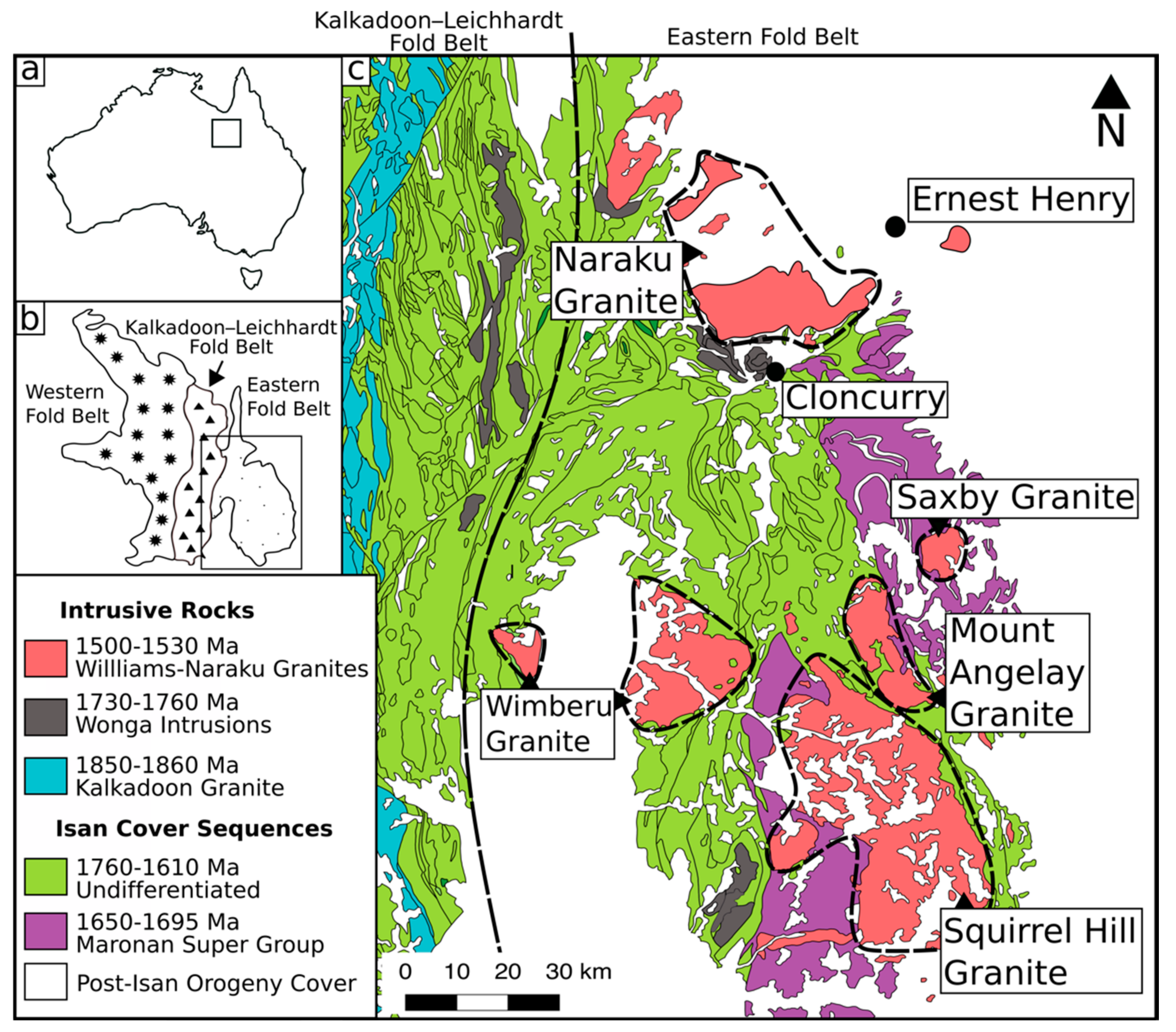
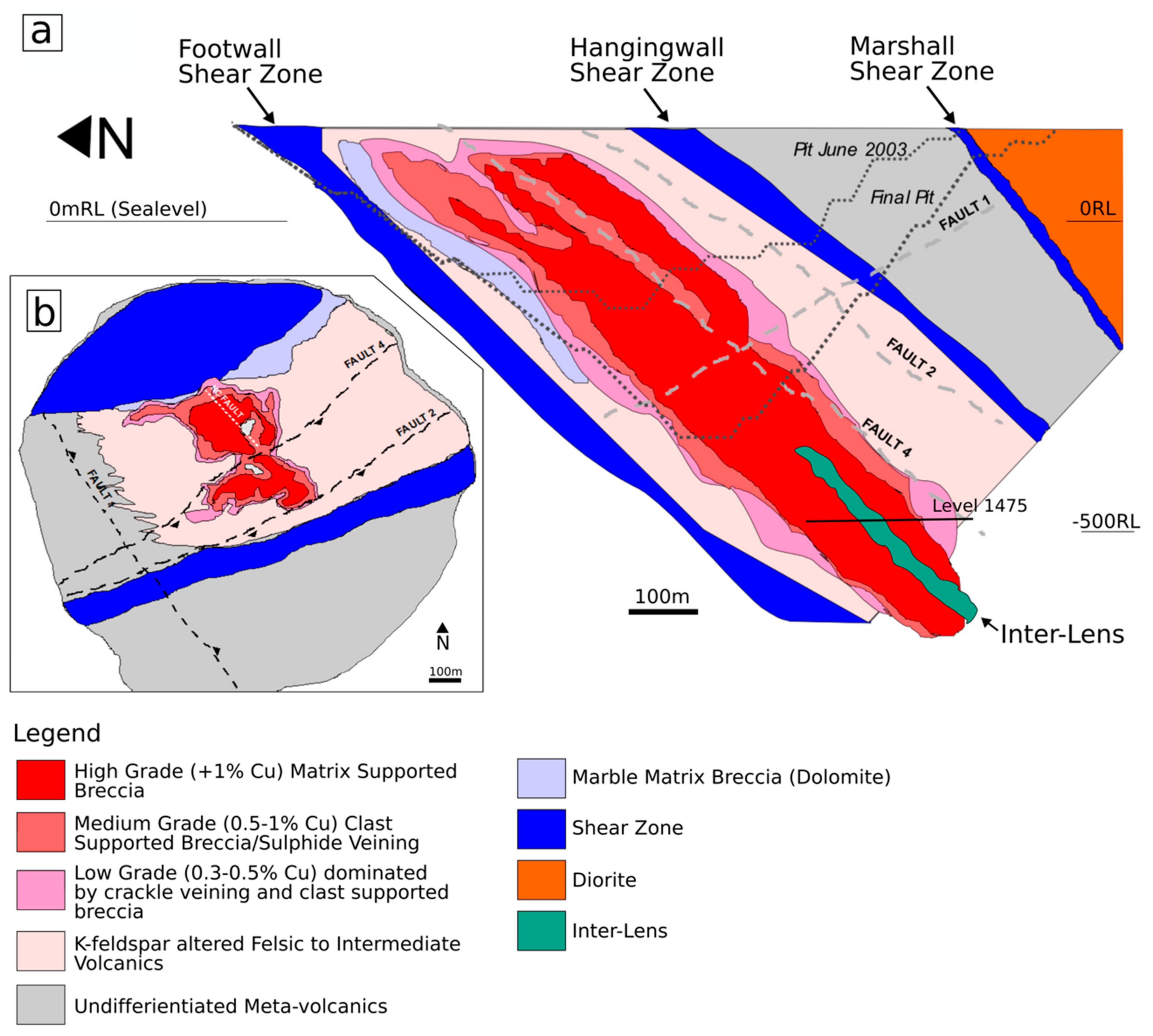
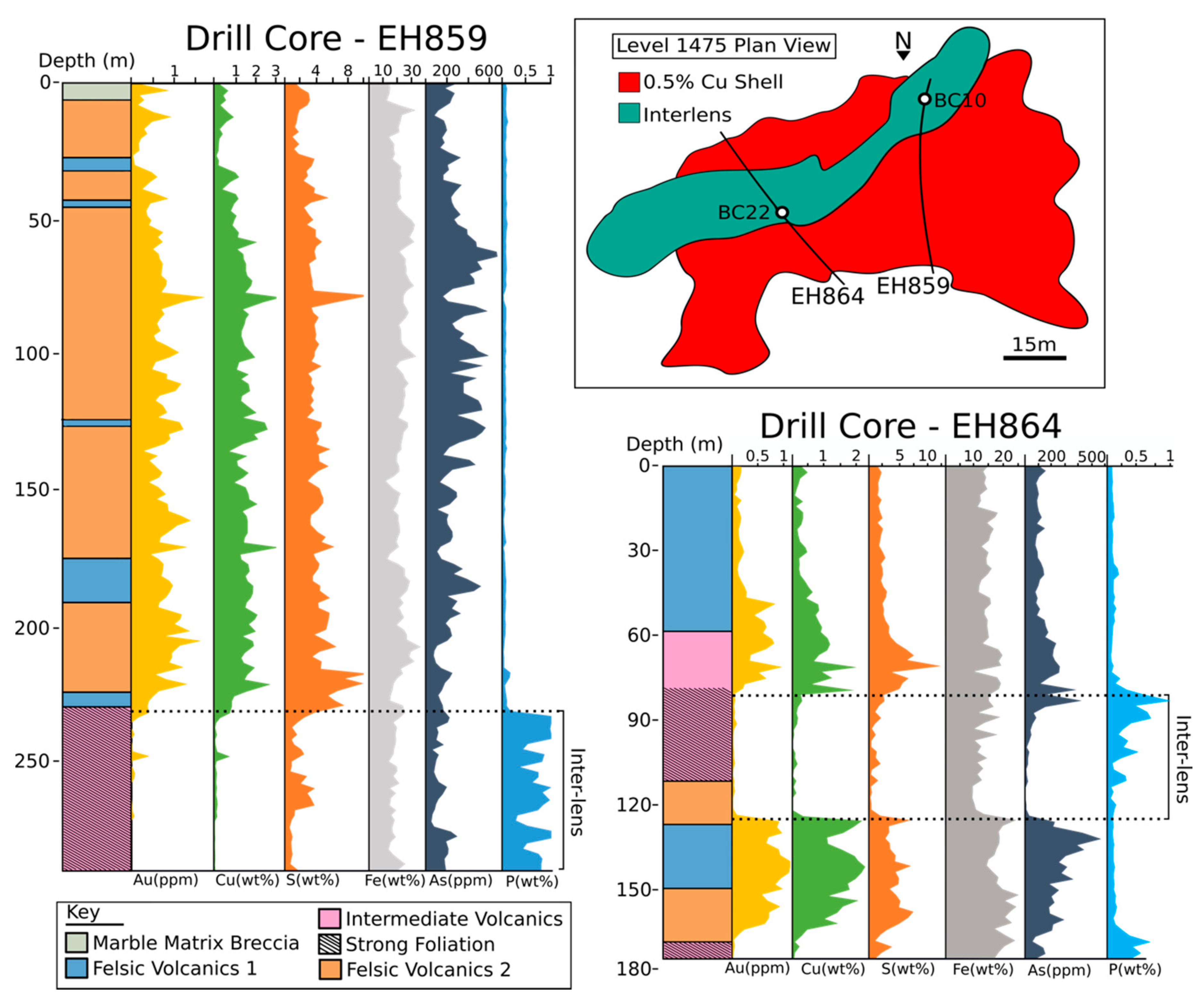
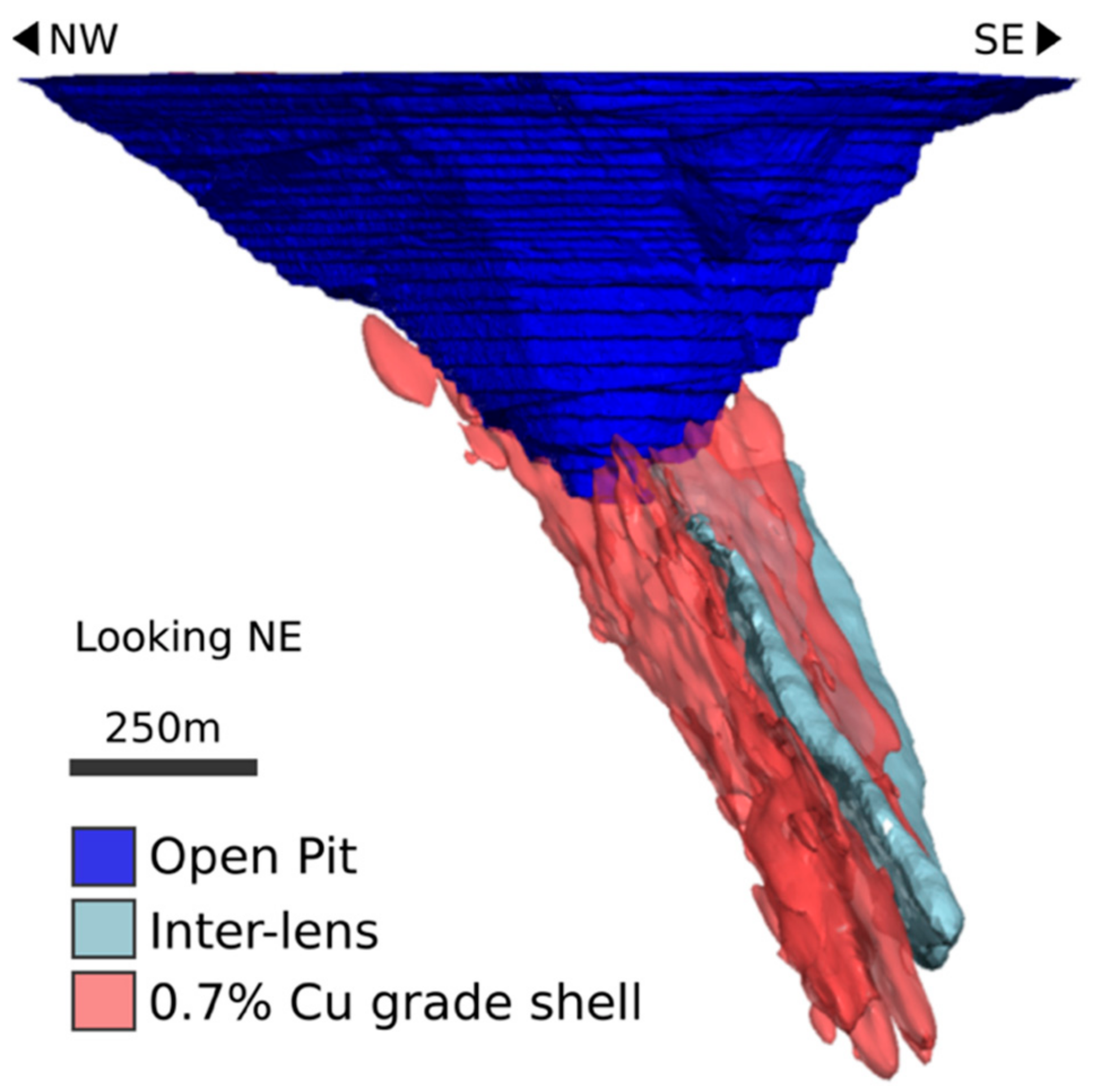
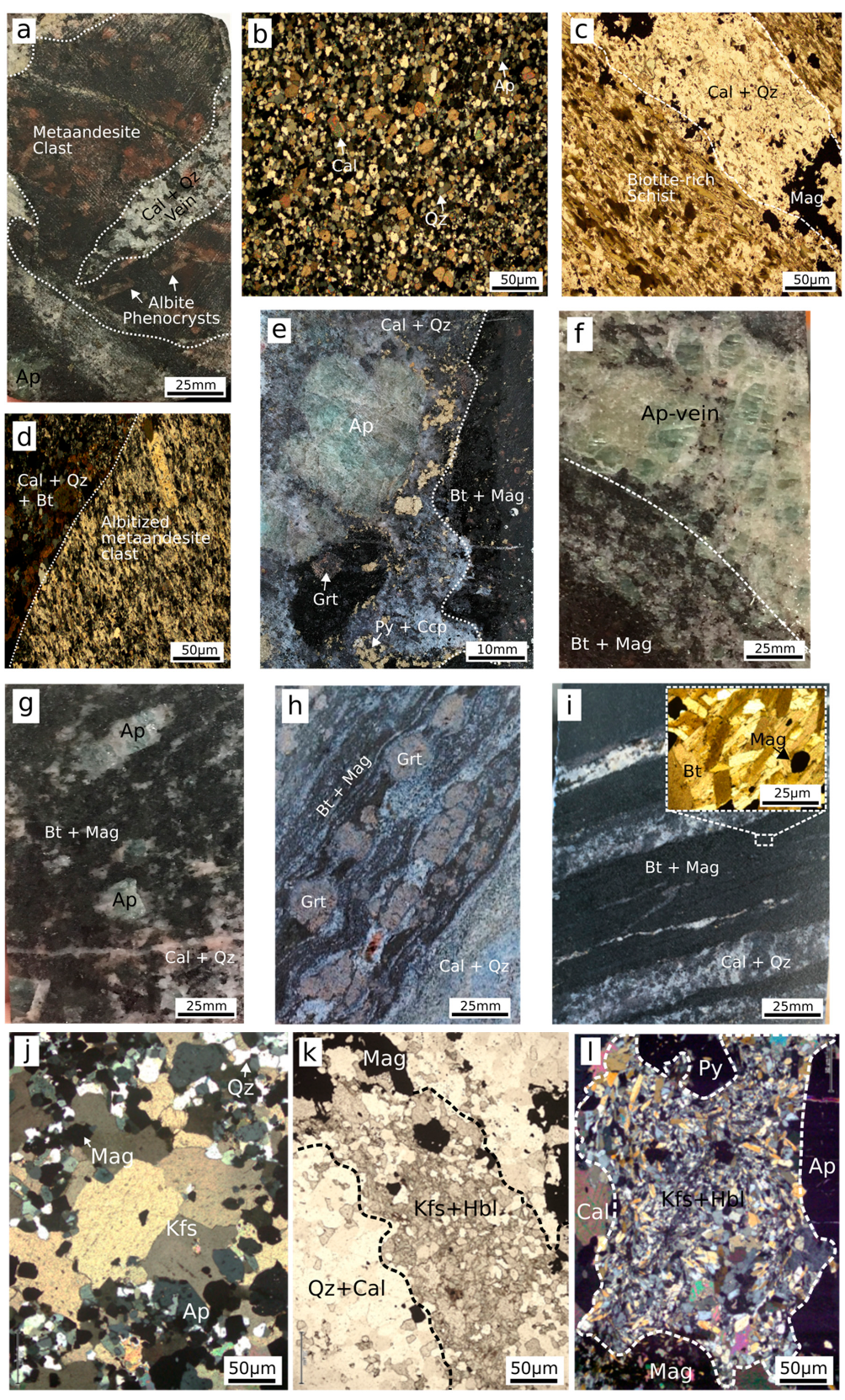
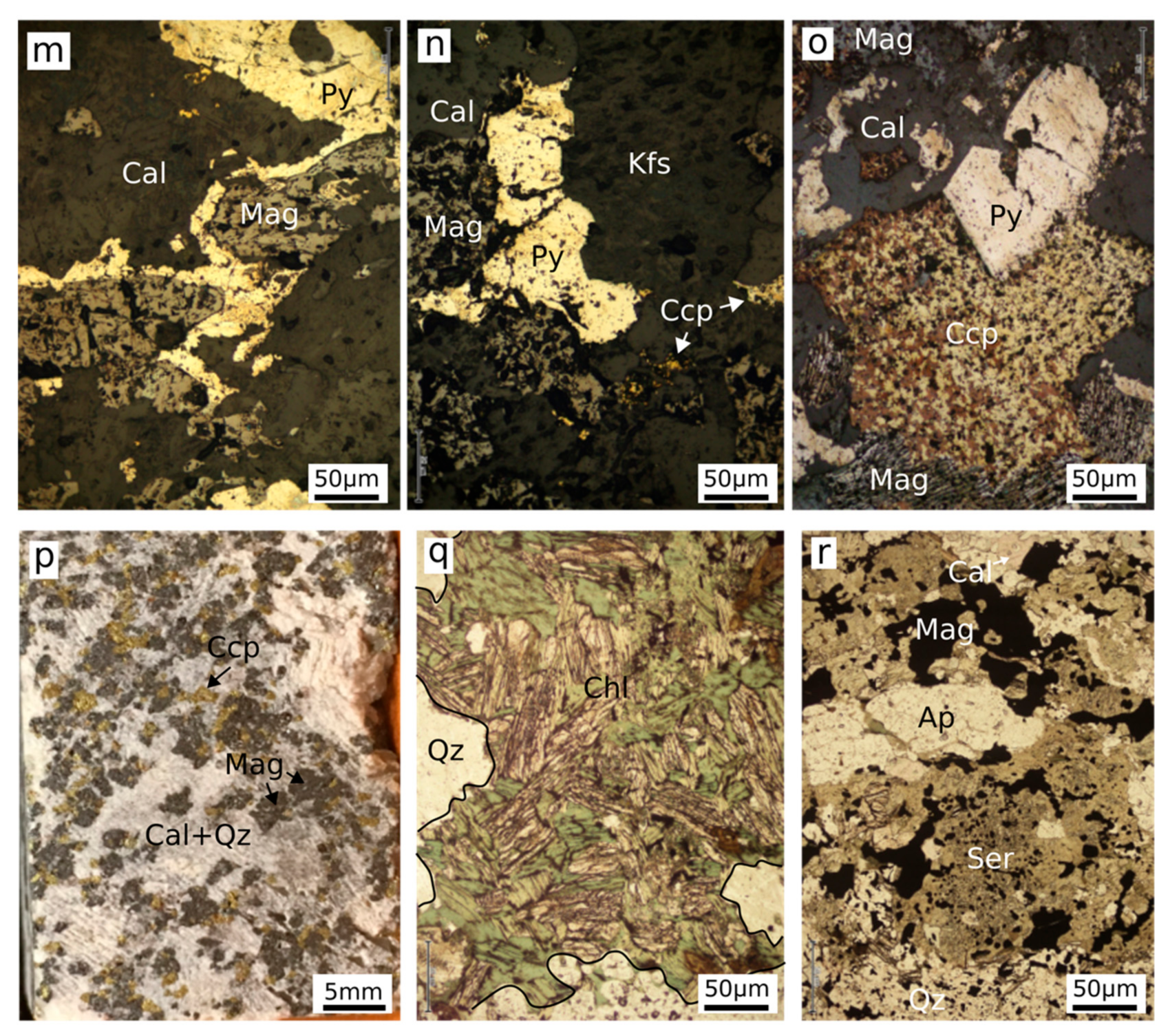
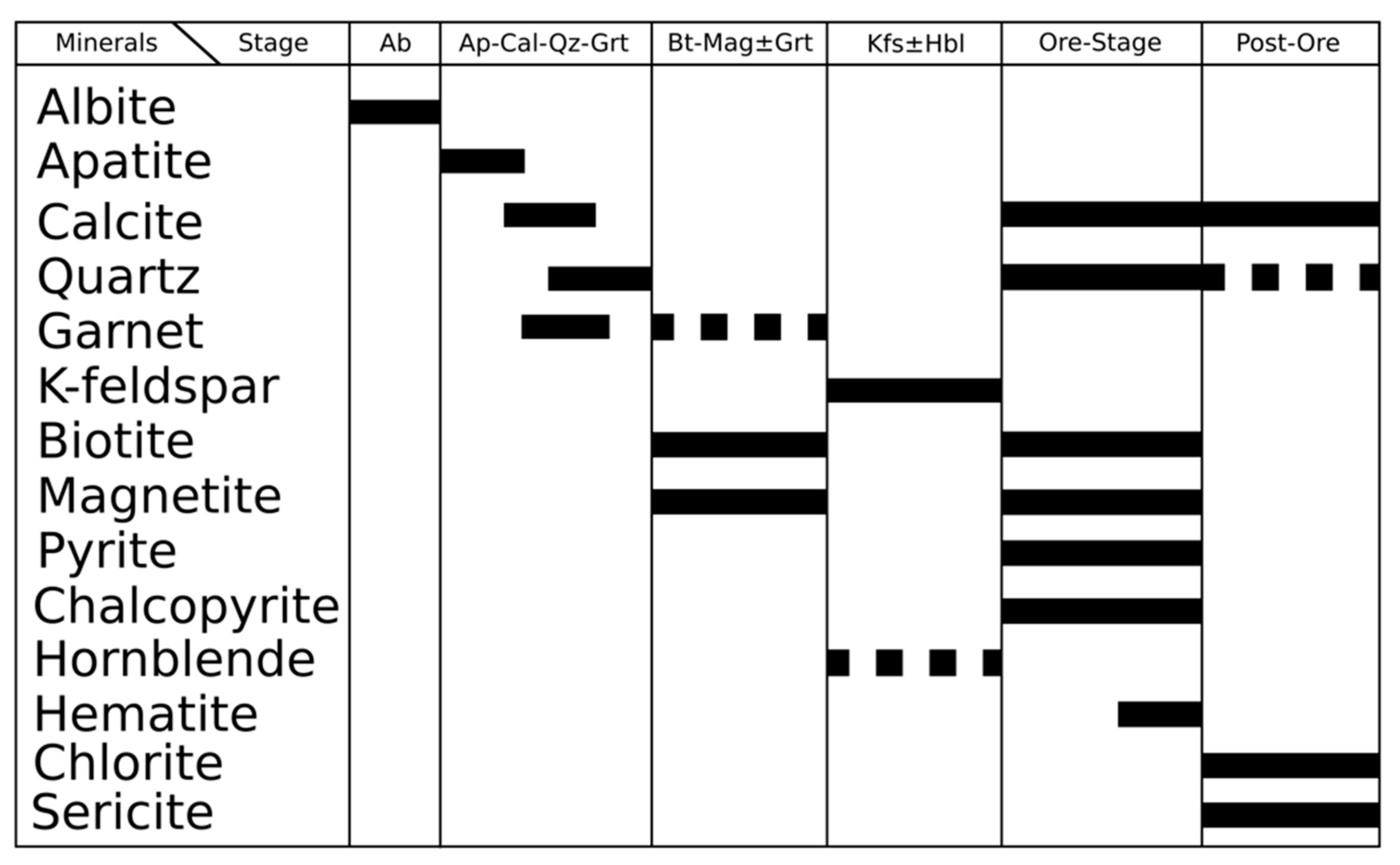
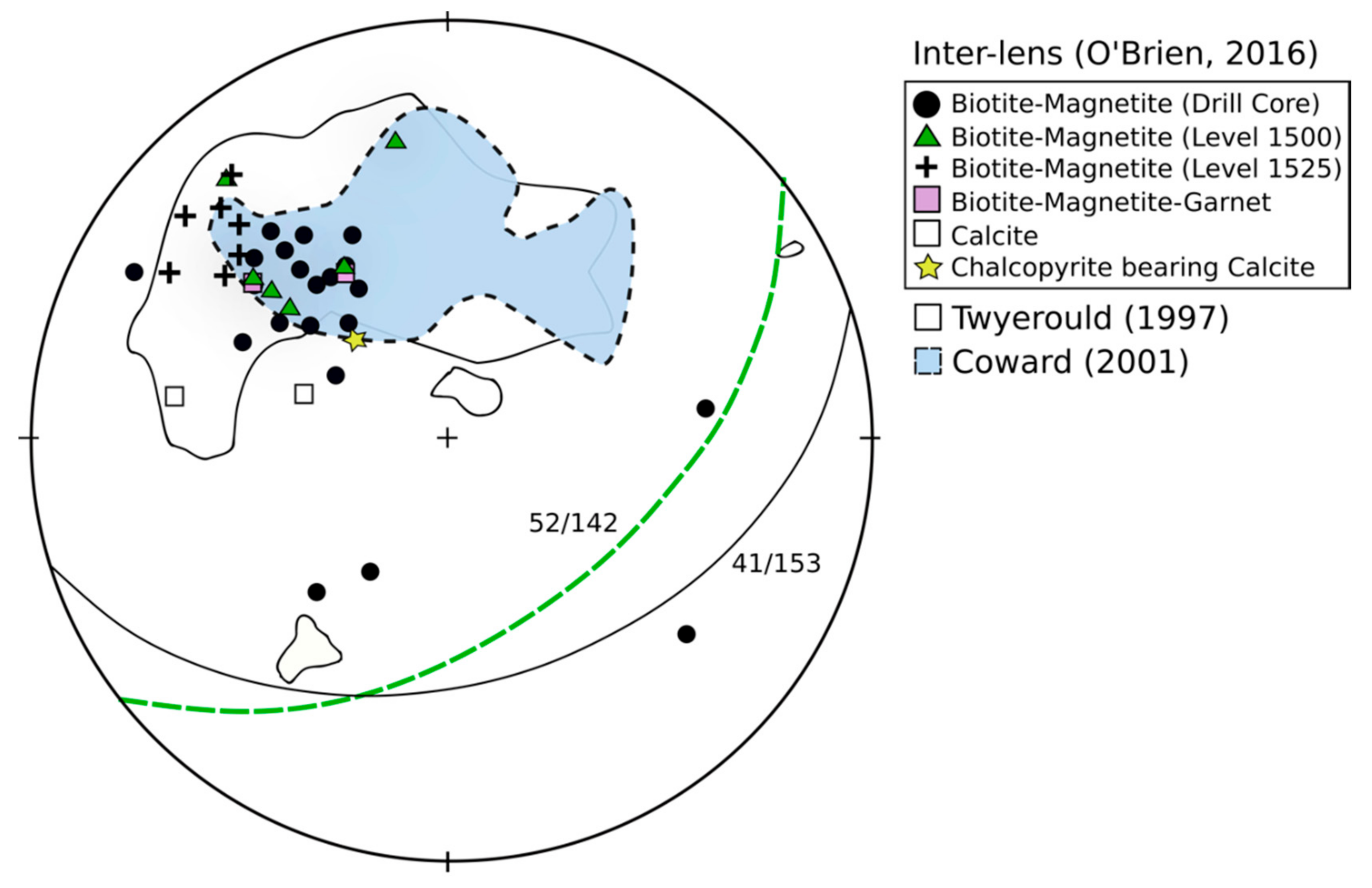
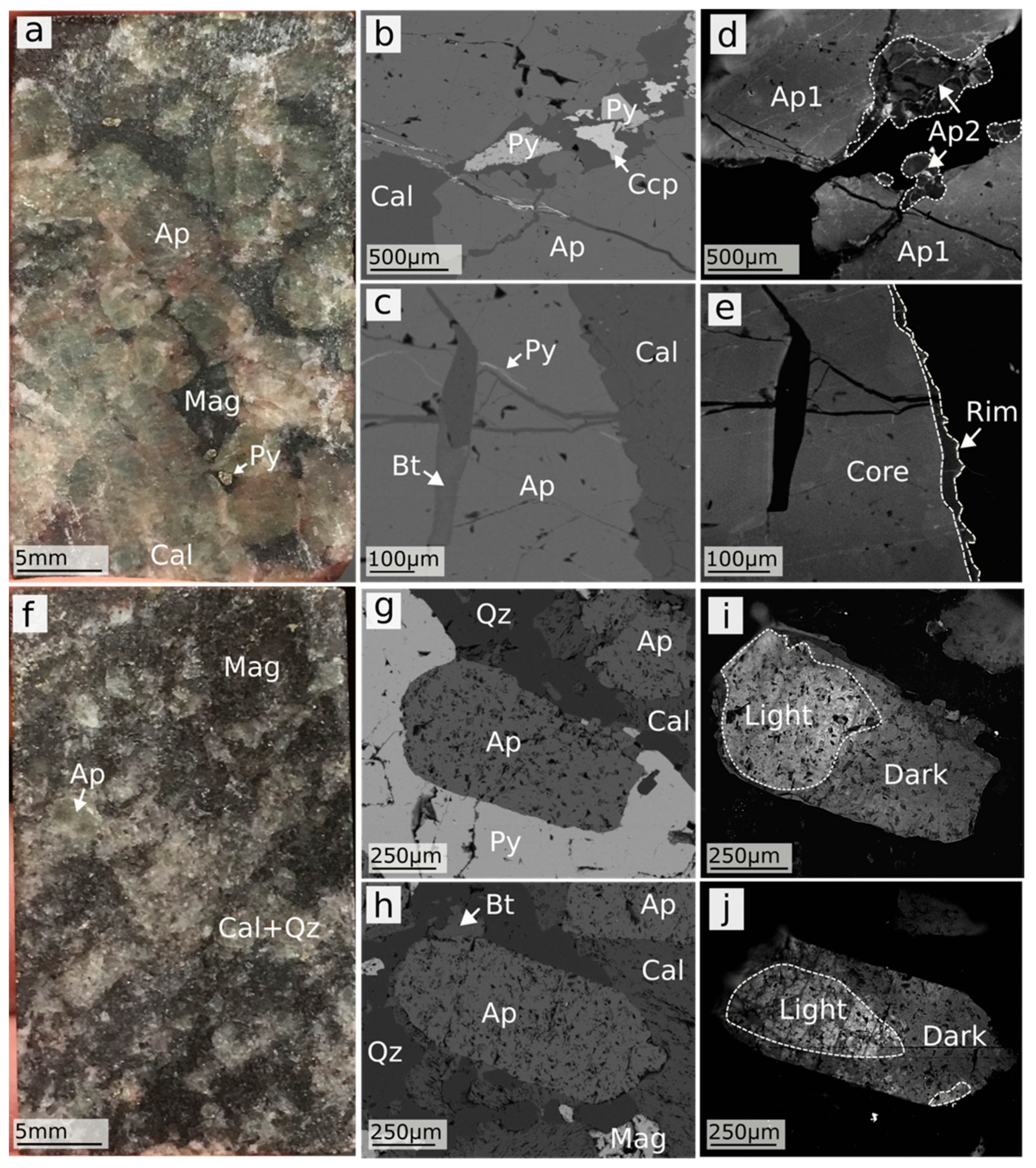
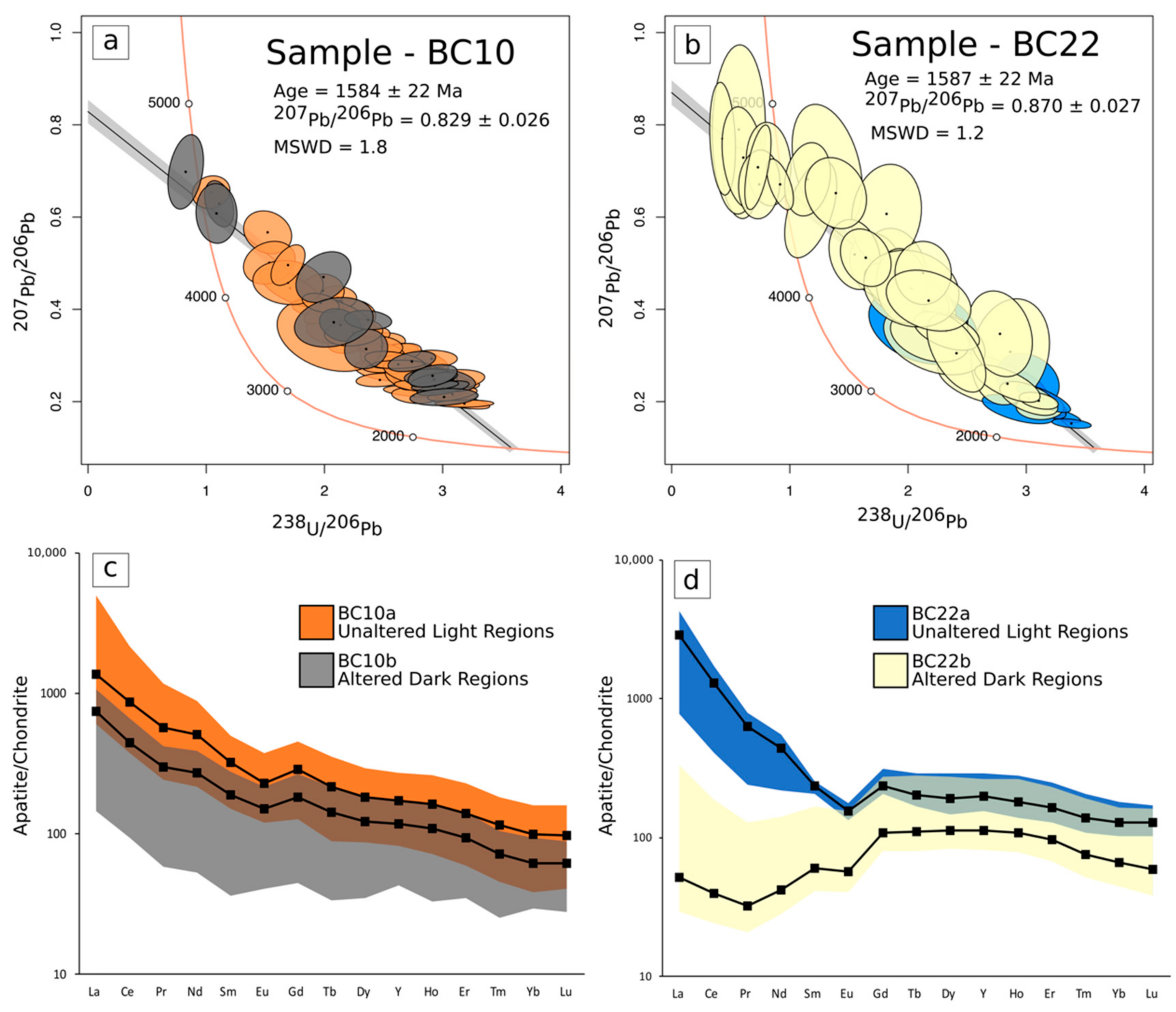
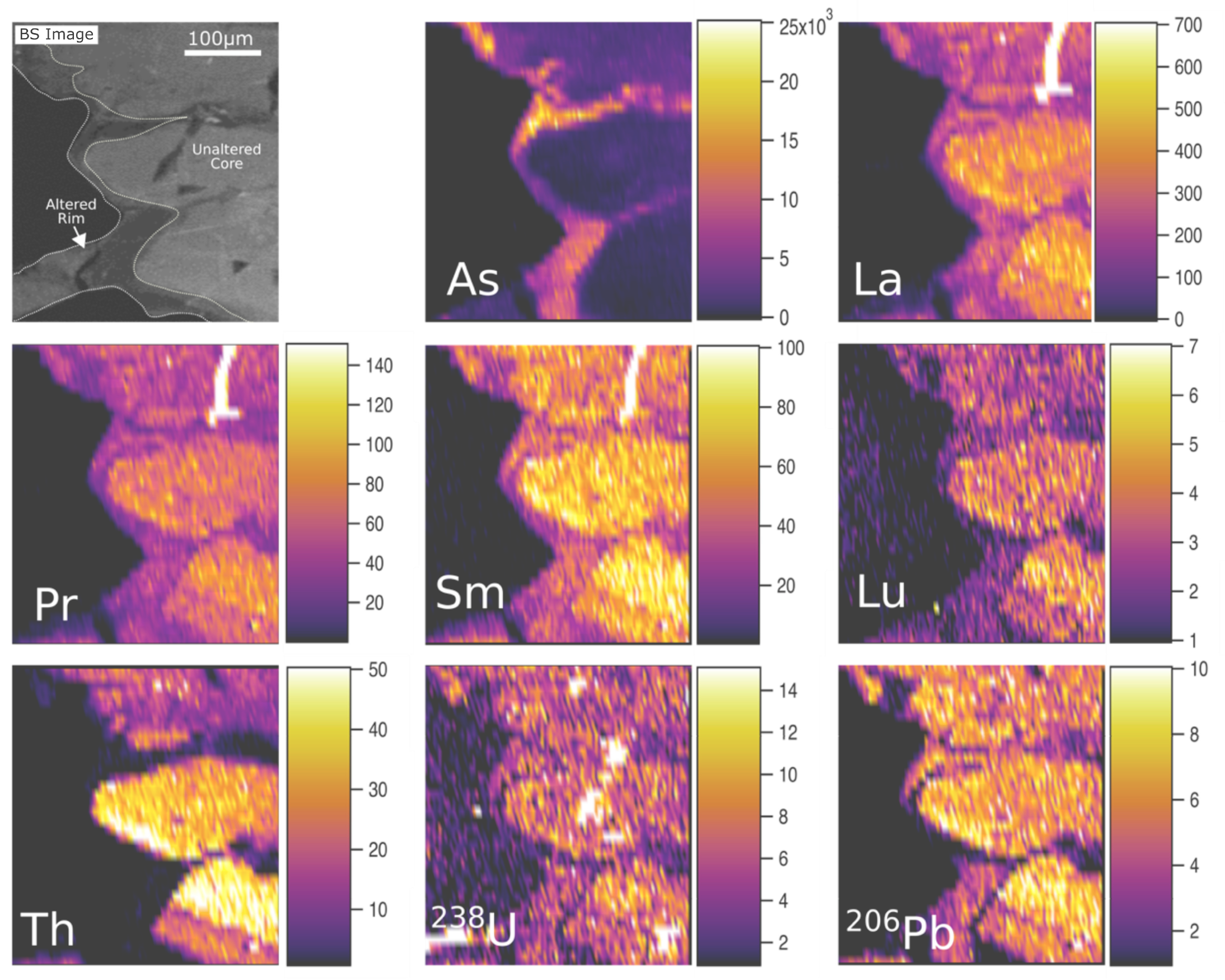
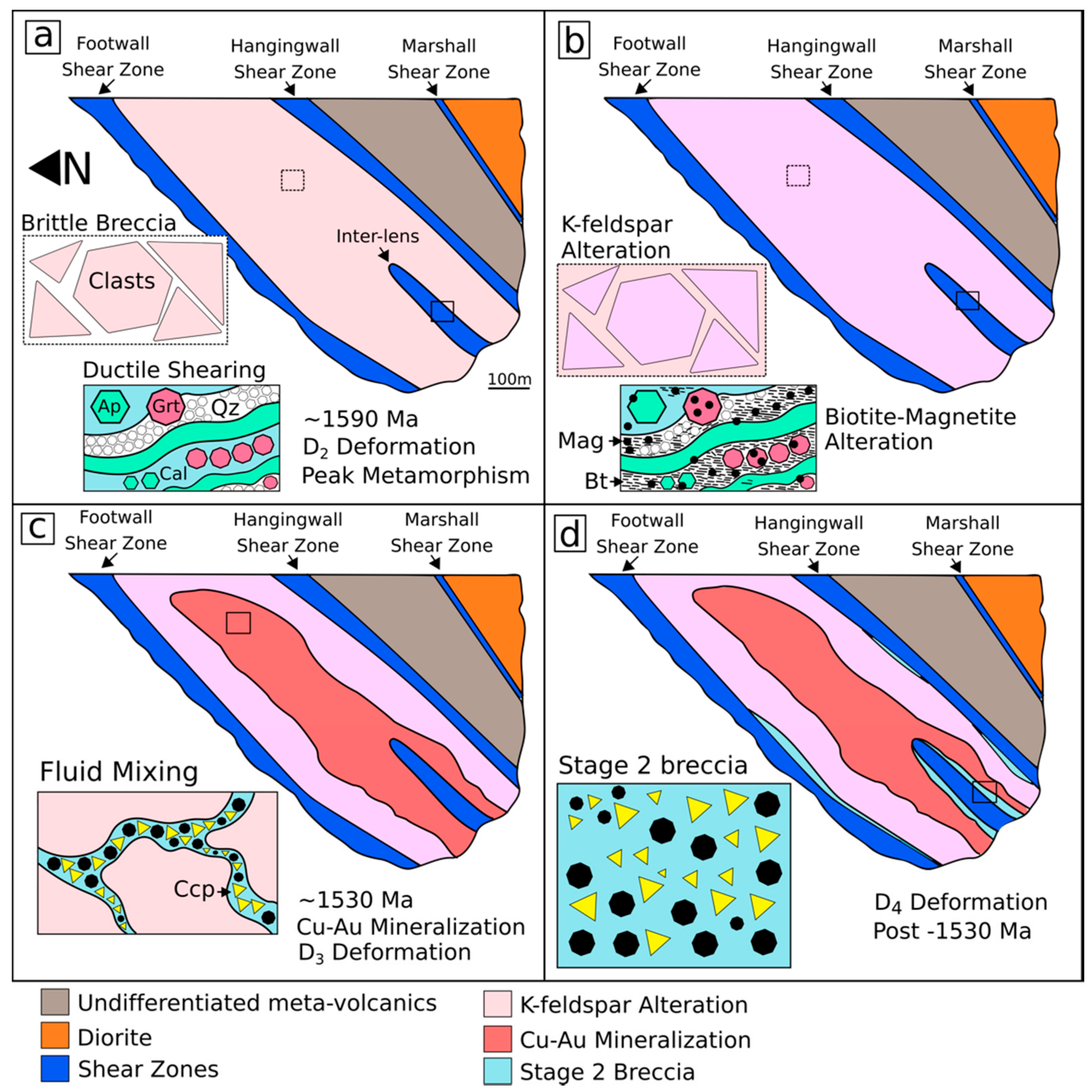
| All Measurements Are in ppm | La | Ce | Pr | Nd | Sm | Eu | Gd | Tb | Dy | Y | Ho | Er | Tm | Yb | Lu | Th | 238U | |
|---|---|---|---|---|---|---|---|---|---|---|---|---|---|---|---|---|---|---|
| BC10a | High | 1180 | 1315 | 111.2 | 411 | 75.6 | 21.9 | 92.7 | 13.12 | 73.9 | 424 | 14.88 | 37.8 | 4.65 | 27.1 | 4.04 | 57.4 | 8.00 |
| Median | 336.45 | 537 | 54.65 | 239.85 | 49.55 | 13.43 | 58.55 | 8.05 | 45.85 | 273.3 | 9.305 | 23.06 | 2.97 | 17.28 | 2.47 | 18.9 | 4.47 | |
| Low | 143.6 | 231 | 22.9 | 101 | 22.9 | 7 | 26.1 | 3.33 | 22.1 | 127.6 | 4.07 | 9.8 | 1.17 | 6.5 | 1.03 | 0.79 | 1.09 | |
| BC10b | High | 252.4 | 405 | 39.8 | 180.3 | 42.1 | 12.59 | 54.8 | 8.04 | 46.6 | 268.5 | 9.22 | 23.53 | 2.67 | 15.84 | 2.23 | 5.08 | 5.82 |
| Median | 185.5 | 303.8 | 31.48 | 143.1 | 30.65 | 9.83 | 40.1 | 5.66 | 32.75 | 195.75 | 6.65 | 16.47 | 1.99 | 11.45 | 1.59 | 1.21 | 3.33 | |
| Low | 34.2 | 57 | 5.5 | 24.6 | 5.5 | 2.35 | 9.1 | 1.26 | 8.8 | 68 | 1.86 | 5.8 | 0.64 | 5.0 | 0.7 | 0.26 | 0.64 | |
| BC22a | High | 1005 | 1043 | 75 | 255.8 | 38.5 | 10.25 | 64.4 | 10.86 | 74.1 | 455 | 15.83 | 41.3 | 5.21 | 30.93 | 4.33 | 39.7 | 7.11 |
| Median | 662.5 | 752.5 | 58.25 | 206.7 | 36.3 | 8.75 | 48.75 | 7.46 | 48.1 | 308.85 | 10.16 | 27.105 | 3.53 | 21.58 | 3.2 | 32.2 | 6.73 | |
| Low | 183 | 251.3 | 22.96 | 102.5 | 31.7 | 7.71 | 42.2 | 6.3 | 37 | 244.3 | 7.89 | 21.06 | 2.74 | 17.3 | 2.6 | 15.7 | 4.80 | |
| BC22b | High | 77.9 | 115.4 | 12.13 | 66.1 | 25.4 | 8.95 | 55.9 | 10.42 | 70 | 412.9 | 14.96 | 38.3 | 4.85 | 27.91 | 4.06 | 37.3 | 5.76 |
| Median | 12.19 | 23.66 | 3.01 | 18.9 | 8.83 | 3.15 | 22.1 | 4.09 | 28.2 | 174 | 6.12 | 15.91 | 1.9 | 10.73 | 1.48 | 2.02 | 0.74 | |
| Low | 6.89 | 14.81 | 1.98 | 13.28 | 6.36 | 2.33 | 16.29 | 2.98 | 21.1 | 128.5 | 4.42 | 11.22 | 1.32 | 7.6 | 0.96 | 0.04 | 0.12 | |
© 2018 by the authors. Licensee MDPI, Basel, Switzerland. This article is an open access article distributed under the terms and conditions of the Creative Commons Attribution (CC BY) license (http://creativecommons.org/licenses/by/4.0/).
Share and Cite
Cave, B.W.; Lilly, R.; Glorie, S.; Gillespie, J. Geology, Apatite Geochronology, and Geochemistry of the Ernest Henry Inter-lens: Implications for a Re-Examined Deposit Model. Minerals 2018, 8, 405. https://doi.org/10.3390/min8090405
Cave BW, Lilly R, Glorie S, Gillespie J. Geology, Apatite Geochronology, and Geochemistry of the Ernest Henry Inter-lens: Implications for a Re-Examined Deposit Model. Minerals. 2018; 8(9):405. https://doi.org/10.3390/min8090405
Chicago/Turabian StyleCave, Bradley W., Richard Lilly, Stijn Glorie, and Jack Gillespie. 2018. "Geology, Apatite Geochronology, and Geochemistry of the Ernest Henry Inter-lens: Implications for a Re-Examined Deposit Model" Minerals 8, no. 9: 405. https://doi.org/10.3390/min8090405
APA StyleCave, B. W., Lilly, R., Glorie, S., & Gillespie, J. (2018). Geology, Apatite Geochronology, and Geochemistry of the Ernest Henry Inter-lens: Implications for a Re-Examined Deposit Model. Minerals, 8(9), 405. https://doi.org/10.3390/min8090405






